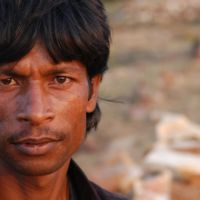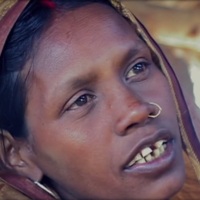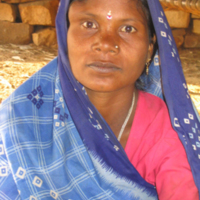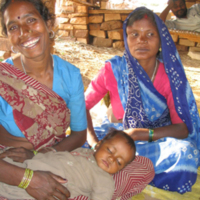
My name is Ramphal. I am 27 or 28 years old. I was born a bonded laborer, and I remember my earliest childhood days. Way back, we were farmers. We all worked in the field, and we were bonded laborers under the contractor. Then we came to the stone quarry and we became slaves. But there is actually no difference between being a bonded laborer and being a slave. It is the same thing. When my grandparents were born, they were slaves. When my parents were born, they were slaves. When I was born, I was born a slave, and the situation really didn’t change until recently—about five or six years ago when my son was born, he was born a slave. And when I went to prison, my daughter was born a slave.
When I say I was a slave, or that my parents were slaves, I want you to understand what I’m talking about. If I wanted to cycle on the road, the moment I stepped onto my cycle I would be stopped and thrashed. The reason? I didn’t get the slave owner’s permission to use the road. If I walked out of my house, if I wanted to sit somewhere, if I wanted to eat, if I wanted to drink, any single action at any point in time, anything that I wanted to do, I required permission. That’s what I mean when I say I was a slave. Freedom of movement was something I didn’t know existed. And it was not just me. My mother, my father, my grandparents had to live through this generation after generation. It was deep in the psyche.
But it was only when we thought about it and became aware, that we realized that we were slaves. The realization came when we looked at the contractor and saw we did all the hard work. We were responsible for loading the trucks. For all the stones we would load onto the truck we would get the measly sum of 250-300 rupees [$5-6] and he would pocket the rest of the 1500 rupees [$30]. At no time were we free to do what we wanted to do or to make our own choices. That’s when we realized we were slaves.
Each time I think back and look at the life that I led in that village, my heart is filled with grief and with sadness. There was just no relationship between the slave owner and us. It was a matter of their mood or their fancy. They would just pick up anyone on the road, anyone cycling, someone’s brother, someone’s son, myself, anyone. Any single individual at any point in time could be just picked up and beaten, no rhyme or reason. My mother, my sister, somebody else’s mother, sister, wife, daughter. It made no difference to them. There was no feeling within them that: “This is my employee, this person works for me.” Almost that you weren’t human. That’s the level of torture for us, the indignity that we suffered from. Understand the fact that everyone was under their control. The slave owners had complete authority. There was not a moment when they would think: “Oh my God, look who’s sitting there, a person.” We weren’t individuals. You have to understand that. Whatever they wanted to do, they could do. We were in total fear of them.
The level of violence against the females was always very high. There were always the situations when we, the men, would go to work. We would go to load the lorries and very often the slave owners would just come inside and do as they pleased with the females. There was nothing you could do. An incident happened in a district not very far from here. An eight-year-old girl was sitting in a house and these landlords came and they just set fire to the house. The girl died. They could do what they wanted to do. As simple as that. The level of fear, the level of constant control that we were under was so high that we were just shaking each time anyone would approach us. There was just no dream. Anything else was an impossibility.
Now the situation has changed. All my children are being born free. They are free men. What happened was that the level of torture and harassment was escalating. There was no end; it kept going on and on.And into this environment people from the municipality came in and talked to us about forming a committee. We got together as an awareness group. Then people from Sankalp came from outside to talk to us. Committees forming made the contractors jittery and because of their jitteriness, they began labeling us as rebel leaders and politicians. The contractors even harassed the Sankalp people and beat them up a couple of times. But somehow something had sunk in at some level. When Sankalp left, about ten mothers thought together and started talking.
There was a thought process about how we should get together and form an organization, this informal committee. The thought processes got conceptualized and formalized, and the entire village joined in unanimously. There was a rally in Falatna and a lot of us went there—almost the entire village got together and went there. There, a lot of issues were raised. It wasn’t an easy rally but as a result there was this feeling spreading among the people, that—”Yes something was happening, something was possible.” These ripples were moving over everyone.
After that, the people of Sankalp would come in repeatedly. They would talk to us, awareness spread, and on the basis of what they told us and what we thought among ourselves, we started walking along a path. A direction was shown and we were moving toward it. Then there was a huge meeting in Ramgarh. A large number of people came. The villages adjoining our village flocked together. The meeting came at a time when the ripples were escalating so there was an expectation in the air that something was going to give, something would happen. That was the feeling that was prevalent among everyone. There was electricity in the air. The slave owners in turn also knew that the meeting was going to happen so they were prepared. Violence was what they had on their agenda. We had an inkling that they knew.
We had all assembled together, about 5000 villagers. We had a meeting peacefully. But as the meeting was about to terminate, we noticed that about ten of the slave owners were circling around the entire congregation. The meeting began to disperse. Some people went to nearby shops to buy stuff, and the slave owners came to these shops and used their bare hands, their shoes, their slippers and randomly began to beat these shop owners and the people buying provisions. There was uproar; people were screaming and shouting. We all turned around and came back to check what was happening. But even then, violence did not erupt. People were asking: “What’s up? What’s happening? What’s wrong? Why are you beating us up?” Then the entire flock of turned around and came back towards this commotion. Now there were 5000 people. A discussion began between the elders of the mob and the slave owners, but the slave owners took pistols and shot them in the air. When the mob heard these shots in the air, that’s when all controls broke loose. Now they were scared, scared for their life and also angry. The mob lost its cool and completely surrounded these ten people. There were sticks being used, blows being thrown around and basically violence erupted. In the chaos and confusion the chief of the slave owners died, and about four others were wounded. The moment the mob realized that death of someone had taken place, calmness resumed.
We all congregated again and moved slowly towards the police station in Bara but there were over 5000 of us and we were on foot. We were walking around the mountain which is a longer winding path so by the time we reached the police station, the slave owners had already reached there. Since their version of the story had reached the police first, they refused to lodge any of our complaints or accept our story. We made a silent protest. We just sat, we just sat on the doorstep of the police station and refused to move, hoping that this demonstration would compel them to register our complaint. In the meantime, the slave owners who had been injured had been rushed to the Allahabad Hospital. Over there, in front of a doctor they named about eight or ten villagers they could think of or who were popular as the people responsible for the mob attack.
On the basis of the testimony that the police got from the slave owners, they took about eight of us and they put us in prison for six months. The families of my fellow inmates were left high and dry. There was no one to look after them. I was at least safe. I was in prison, there was no fear of any landowner, any slave owner. But at the same time all of the fellow mob members were severely harassed by slave owners. They were under constant pressure. I had no hope that I would see the earth again, that I would be free, but after six months, I was released. My release was a combined effort of a lot of people—the members of Sankalp, my self-help group, fellow villagers, people from other villages. They all tried very hard, spoke to a lot of officials, gathered money for my bail application. Sankalp moved every single rock to get me freedom. But afterwards the slave owners had banned my reentry into my own village.
Right about that time of the Ramgarh meeting, a girl was burnt alive by the landlord for no rhyme or reason. It’s all connected, these incidents that took place one after the other. And as a result of that, the houses were burned by the landlord. When the looting happened, eight of us men were in prison. Houses were looted; the women weren’t protected; the men weren’t there. Every household item that you can think of—clothes, suitcases, food, baskets, water—was completely destroyed, burned, looted. In all 40 houses, not one needle and thread could be found. Gone, all gone. That was a bumper year, there was a great amount of crop. Every house, no matter how poor, had about ten or 20 quintals of rice and wheat all stocked up. Even that if the crops had failed for the next two years we would have survived. But all of that, every single speck of grain was gone. You think we would have complained to the police, taken some legal action, but they were hopeless. They had taken so much money as bribes that they were standing while the houses were looted, just standing and watching.
We all moved to land close to my former village. The belief was so strong among all of us, this feeling of brotherhood that we now share, that we all actually formed this entire village just by ourselves, and we named it Azad Nagar—”the land which is free.” This means so much to us, the fact that it self-proclaimed, that we all led a march one day. If you just stretch your eyes one day, you might catch a glimpse of it.
I’m so happy with this new life that I’ve got. It gives me so much joy—the fact that I can control my own mind, my own thoughts, my own movements. I can’t even look back at my earlier existence. Now we are in control, to do what we want, when we want, how we want. I had taken a loan of about 5000 rupees [$100] but today I’m a debt-free man. The work is the same, but there’s a fundamental difference. Earlier I could not control the hours I wanted to work, when I went to work, how I wanted to work. Now I can. Before, if the vehicle came, I would load it right there and then, no matter what I was doing. Now I can go and work in the mountain and work for as long as I want. If I don’t want to work I can come back and rest. I can go outside the village, go meet someone, talk to someone. I’m master of my own mind, my own destiny. That’s a big difference. I can do what I want to do. I am free. The very fact that I’m sitting here and I’m able to take time from my hectic day’s work speaks about today.
Today I’m free to not only live as I want to live buthope for a better future. My dream is now to start some kind of business, to have earnings and savings for myself and for a better future for my children. The dream is very big. I’m a little scared that it might not come true. I want my child to study, to become big, to do something, to be successful in all that he does. It’s so grand, so big a dream.
I have dream that tomorrow we’ll be able to continue the unity we have waked up and take this unity towards a more progressive future for us and everyone in my village.
Ever since we have obtained our freedom, we’ve talked to the other people who are still slaves. We keep telling them that all we want is for them to live an independent life like we do, and that’s what we want for anyone and everyone who’s under slavery. We are trying. I am trying and all the fellow volunteers of Sankalp are also trying very hard to get them out of bondage.
When I was a slave, I never dreamt I could go to Delhi, and now I have. In fact, I’ve been put in charge of all the running around that has to be done between the big cities. Whenever I go to these places, I learn, I become aware, and I come back and I impart this awareness to my fellow villagers and also to the other people who are working in bondage. We meet them and talk with them and they listen. It’s not like they don’t. They do. But then they forget, or they’re too scared of the landowners. That doesn’t matter. We keep telling them, showing them our life, the life we lead now, and they’re keen to get out of bondage, so it’ll happen. It’s just a question of time.
My life today is so much better that all I can think about is coming generations—they will be even better than mine. I don’t know exactly what will change, but there will be a change. That’s my wish. That’s my desire. We are doing this in spite of being free. You know our motto for the villages? Just like we are able to break this hard hard rock with the hammer, any enemy is going to be shattered because of the unity that we now have.
Narrative as told to Peggy Callahan for Free the Slaves, November 2, 2004, in Azad Nagar, Uttar Pradesh, India.


